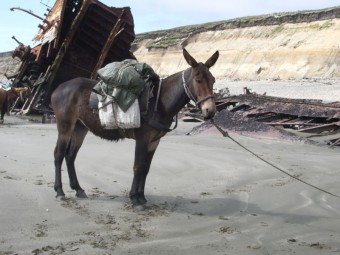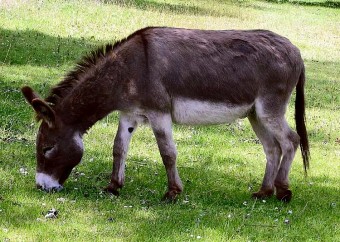Difference Between a Donkey and a Mule
Today I found out the difference between a donkey and a mule.
Put simply, a donkey is the descendant of the African wild ass (of which there are only about 500 left in the wild today). Donkeys are a different species than a horse, but in the same family. They were originally bred in Egypt or Mesopotamia around 5,000 years ago.
Mules, on the other hand, are a cross between a female horse and a male donkey or “jack” (hence the word “jackass”). In contrast, a male horse and a female donkey bred together produces a “hinny”; the name coming from the fact that a female donkey is called a “jenny”, bred with a h-orse. The offspring of this breeding is very similar to a mule, as you might expect, though generally slightly smaller, which is thought to be because of the smaller womb in a donkey over a horse.
So, the main difference between a donkey, mule, and a horse is genetics. Horses have 64 chromosomes; donkeys have 62, leaving the mule and hinny with 63. This mismatch in pairs leaves the mule and hinny almost always sterile, though there have been about 60 recorded instances of a female mule able to conceive with a horse or donkey.
Beyond the genetic difference, you can easily tell the difference between a donkey and a mule or hinny by a few different physical markers. The easiest thing to spot is that mules and hinnys are usually larger than donkeys (often significantly so), much more closely resembling a horse in size. In fact, it’s not that uncommon for a mule to be taller than both its donkey father and horse mother.
Another easy difference to spot is that, in the summer, a mule’s coat tends to more closely resemble a horse’s, rather than the longer, coarse hairs of a donkey. However, in winter mules tend to develop coats that more closely resemble a donkey.
Less noticeable at a glance is that donkeys lack the fifth lumbar vertebrae in their spine which horses and most mules possess.
Besides physical and genetic differences between a mule and a donkey, you can also tell the difference just by hearing them make noises. Donkeys make very distinctive hee-haw type sounds. Mules make a sound that is something of a cross between a horse’s whinny and the donkey’s hee-haw, often starting as a whinny and melding into a hee-haw.
Bonus Donkey and Mule Facts:
- If you ever wondered why anyone in an agricultural setting would want an animal like the mule that can’t reproduce, it’s simply because, in a lot of ways, a mule is superior to both a donkey and a horse, taking many of the best traits of each. For instance:
- Mules are significantly more “maintenance free” than horses, particularly having less leg and hoof problems, but also less medical problems overall. If they primarily work on softer ground (not concrete or exceptionally stony ground), they don’t even need to be shod.
- Mules have tougher and less sensitive skin than horses.
- Mules live longer than horses (as high as 50 years, compared to the horse’s 30-ish years). They also have a greater number of years where they can be productive, averaging about 18 years to a horse’ 15 years of productivity on a farm-like setting. Further, mules can be used as many as 30-40 years for riding, long after the horse would be dead.
- Mules also require much less in the way of high quality food (no grain needed). They are typically fine with the more nutritionally deficient fare donkeys are accustomed to.
- They need less food, pound for pound, than horses, with a much more efficient digestive tract (needing only around 1.5% of their body weight per day, compared to a horse’ 2.5%, though this varies somewhat depending on how much work they’re being given. But the same basic ratio holds if they are given equal work.)
- Pound for pound mules are also stronger than horses and with better stamina and agility. They also are superior to donkeys in that they are typically much larger than donkeys, so the overall weight they can carry is greater.
- Mules make great guard animals for protecting livestock, similar to donkeys, but not quite as aggressive. Horses, on the other hand, tend to lean towards bolting when they sense danger, only fighting when they have to.
- Mules, like donkeys, also have a very strong “self preservation” sense, which makes them naturally a better companion in a fight with wild animals, and also better in the sense that they won’t let you work them to the point of death, like can happen with horses if you aren’t careful.
- Mules don’t spook as easy as horses do, making them better to ride in certain circumstances, such as in settings like trails down the Grand Canyon or in a storm.
- Finally, mules endure heat and lack of water much better than horses, gaining this trait from their donkey father, who is built more for desert life.
- Donkeys are incredibly good guard animals for livestock. The downside of this is that they must be trained not to attack pet dogs. Normally, if they see a dog (or a wolf/coyote), they’ll attack, quite effectively.
- Zebras and donkeys can breed together, creating a “zonkey”. Generally such breeding takes place between female donkeys and male zebras as domestic female zebras’ breeding schedules tend to be booked for creating purebred zebras, unlike female donkeys who are much more numerous.
- According to the International Commission of Zoological Nomenclature, the scientific name for a donkey is Equus Africanus Asinus.
- The donkey’s rapid rise in population from its inception is thanks to the fact that donkeys provide extremely cheap agricultural labor, pound for pound able to bear more weight than a horse, while able to walk large distances in a day. They also require less sustenance than a horse of the same weight and are able to subsist on very low quality roughage, compared to a horse, with much more efficient digestive tracts (though the reason this is the case, isn’t entirely understood as there is no marked difference between the two gastrointestinal tracts). Their hooves are also more durable than horses, naturally taking much longer to wear down. Basically, as listed above, you take most of the things that make donkeys great and cross them with the things that make horses great and you get the mule. If mules weren’t sterile, horses and donkeys would likely be significantly less common than they are today.
- Donkeys weren’t called “donkeys” until around the late 18th century. Before then, they were just called “asses”. Nobody knows exactly where the word “donkey” derives from, but the leading theory is that it comes from “dun”, meaning “dull gray-brown” mixed with “monkey”. It’s thought the common switch from “ass” to “donkey” came from the trend towards avoiding derogatory terms, as “ass” had become at that point, particularly in North America. This is similarly to the switches around the same time from “cock” to “rooster”, and “coney” (coney->cunny->cunt) to “rabbit”.
- “Arse”, meaning butt, gave rise to “ass”, meaning butt, instead of just “donkey” or “idiot”, around the 17th century when changes in pronunciation resulted in the two words being pronounced the same; similar to what happened with burst->bust, curse->cuss, barse->bass).
- “Ass” comes from the Latin “asinus”, meaning “donkey”, which in turn probably comes from a pre-Latin Middle Eastern language. Figuratively, “asinus” could also mean “idiot”, basically, “like a donkey”. So the convention of using “ass” to mean “donkey” or “moron” has been around since the beginning of the word.
- “Arse”, meaning buttocks, comes from the Old English ærs, meaning “tail, rump”, which in turn comes from the Greek “orros”, meaning “tail, rump or base of the spine”.
- “Mule” comes from the Old French “mul”, which in turn comes from the Latin “mulus”, both meaning “mule”. As to where that Latin word came from, nobody knows.
- Donkeys are generally considered extremely stubborn animals. Like mules, however, their stubbornness generally only comes up when they feel like they are being forced into a dangerous situation, such as being pushed too hard, past their physical limits, or the like. For mules, this “stubbornness” tends to be a good thing as they’re more willing to be put in a dangerous situation for a master they trust over what a donkey would do, but not so much that they’ll sacrifice themselves, as in a horse that will run themselves to death if accidentally pushed by an inexperienced master, or who might be willing to run off a cliff or into something if they think you’re telling them to, such as if you aren’t paying attention.
- Today there are around 41 million donkeys in the world with about 185 different breeds. The largest population of donkeys can be found in China, which has about 11 million.
- The U.S. army still uses mules to carry supplies in Afghanistan in places where the terrain is particularly rugged.
- While mules are almost always sterile, they have been successfully cloned, the first of which was in 2003 at the University of Idaho in conjunction with Utah State University.
| Share the Knowledge! |
|









Typo in paragraph six: “rather than the longer, course hairs of a donkey” should be “rather than the longer, coarse hairs of a donkey”
@Rebecca Brooks: Good catch, thanks!
Of coarse! Or, of course!
Of coarse, a horse, of course,
Not all donkeys are canine aggressive and do not make excellent guardians. The very negative aspect to encouraging this myth is that even minis will be used as guardians. Because of their diminutive size, are prey themselves. Get a LGD or Great Pyrenees to guard your livestock.
Donkeys are not stubborn, ithey’re incredibly smart. If there is no trust between the donkey and their human or they perceive any danger in what is being asked of them, they won’t do it. Unless someone has loads of patience, a donkey is not for them. We have 17, including the donkeys we foster for a very large donkey rescue.
>>>nutritionally deficient fair donkeys
“fare”
@Eric: Thanks, fixed!
Thank you for this excellent explanation!
Now I know why Clint Eastwood rode one!!
Well written, succinct article from one who is a horse’s arse when it comes to all things equine. Thanks for the primer!